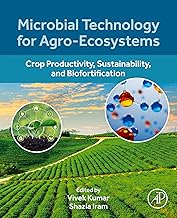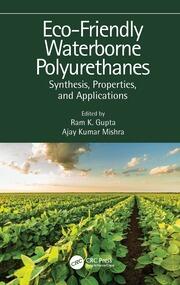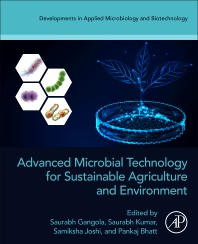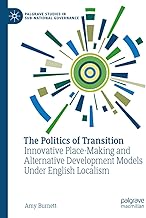
Book
Microbial Technology for Agro-Ecosystems
ISBN : 9780443184468
Author : Vivek Kumar,
Publisher : elsevier
Year : 2024
Language : Thai
Type : Book
Description : Cover image Title page Table of Contents Copyright Contributors Preface Introduction Part I. Microbes in crop productivity and sustainability Chapter 1. A guide for the analysis of plant microbial communities through high-throughput sequencing methods 1. Introduction 2. Shotgun metagenomics 3. Metatranscriptomics 4. Conclusions Chapter 2. Design and application of microbial biofertilizers 1. Introduction 2. From the lab to the field: Generalities of importance in the development of bioformulations 3. Success of a given bioformulation: Focus on carrier selection 4. Carrier roles in crop stress alleviation under field conditions 5. Current state of legislation and bioformulation marketing worldwide 6. Conclusions and future perspectives Chapter 3. Bioprospecting of microbial bioactive molecules for the management of biotic and abiotic stress 1. Introduction 2. Abiotic stress 3. Biotic stress 4. Conclusions Chapter 4. Upscaling plant defense system through the application of plant growth-promoting fungi (PGPF) 1. Introduction 2. Plant growth-promoting fungi (PGPF) 3. Plant growth-promoting and biocontrol potential of PGPF 4. Constitutive versus inducible defense against pathogens 5. Mobilization of plant defenses against pathogens 6. Systemic acquired resistance (SAR) versus induced systemic resistance (ISR) 7. ISR by PGPF against plant pathogens 8. Mechanisms of PGPF-mediated ISR 9. Conclusion and future perspective Chapter 5. Trichoderma as ecofriendly tools for sustainable agriculture management: Improving plant health, crop productivity and soil fertility 1. Introduction 2. Trichoderma: a fungus that offers several avenues for sustainable agriculture 3. Ecosystem of Trichoderma 4. Molecular mechanisms of Trichoderma on crop productivity (growth, quality & yield) 5. Production of hormone 6. Production of siderophore 7. Production of volatile organic compounds (VOCs) 8. Production of enzymes 9. Trichoderma induced expression of plant growth related gene 10. Mechanisms of Trichoderma on plant disease management 11. Plant immune response to root colonization 12. Plant protection by a direct mechanism 13. Antioxidant mechanism 14. Compatible solutes 15. Hormonal reaction 16. Metagenomics analysis and Trichoderam impact on soil microbiome 17. Trichoderma phytoremediation and environmental clean up 18. Conclusions and remarkable future Chapter 6. Microbes in plant health, disease, and abiotic stress management 1. Introduction 2. Plant-microbes molecular interaction 3. Microbes in plant health and diseases 4. Microbes in abiotic stress management 5. Role of omics technologies 6. Challenges with crop sustainability and microbe-based fertilizers 7. Conclusion and future prospects Chapter 7. Review on plant-microbe interactions, applications and future aspects 1. Introduction 2. Types of interactions 3. Amensalism/antagonism 4. Plant competition 5. Commensalism 6. Application of plant-microbe interaction 7. Conclusions 8. Future aspects Chapter 8. Plant growth promoting rhizobacteria (PGPR): A green approach to manage soil-borne fungal pathogens and plant growth promotion 1. Plant-associated bacteria—A general overview 2. Bio-stimulants and green revolution 3. Rhizosphere: A battlefield for microbial survival 4. Microbial antagonism 5. Plant Growth Promoting Rhizobacteria (PGPR) 6. PGPR physiology 7. Indirect influence of PGPR 8. Genome insights into PGPR 9. Molecular mechanisms of PGPR 10. PGPR interaction with plants: Metabolomic 11. Induced resistance: PGPR determinants in ISR SAR 12. Antagonistic activities: Siderophores, bacteriocins and antibiotics production 13. PGPR in agronomic biofortification 14. Role of PGPR in plant development 15. Mechanisms of action of PGPR to improve plant growth 16. Role of PGPR in combating plant stress markers under abiotic stress 17. OMICS for PGPR community dynamics 18. Potential applications of PGPR 19. PGPR formulations and application method as biofertilizer 20. Roadmap to commercialization of PGPR Chapter 9. Cell wall degradation: Microbial enzymes in service of sustainable agriculture 1. Introduction 2. Cell wall degrading enzymes (CWDEs) 3. Application of cell wall degrading enzymes in sustainable agriculture 4. Conclusion Part II. Microbes in agro-ecosystem remediation Chapter 10. Microbial remediation applications in mitigating soil pollution 1. Introduction 2. Soil pollutants 3. Strategies to mitigate soil pollution 4. Conclusion Chapter 11. Sustainable eco-remediation achieved via plant-microbe interactions 1. Introduction 2. Microbial phytoremediation, crop productivity, and sustainability 3. Auspiciousness of the microbial assisted phytoremediation 4. Omic and molecular/biological aspects of phytoremediation 5. Conclusions and future perspective Chapter 12. Plant growth-promoting microorganisms: Ecology and use in sustainable agricultural systems 1. Soil plant growth-promoting microorganisms Part III. Biofortification in sustainable agro-ecosystem Chapter 13. Linking plant growth promoting arbuscular mycorrhiza with sulfonate desulfurizing bacteria 1. Introduction 2. Materials and methods 3. Results 4. Discussion Chapter 14. The role of microbes in biofortification for a sustainable nutrient management and agricultural crop productivity: Current trends and imminent challenges 1. Introduction 2. Hidden hunger and micronutrient deficiencies conditions: An urgent need for biofortification 3. Microbes-assisted biofortifications of food crops 4. Molecular basis of microbe-assisted biofortification of essential micronutrients 5. Modern biofortification: Metabolic engineering of microbes and “omics” as emerging molecular tools 6. Application of nanotechnology in biofortification and future perspectives 7. Conclusion Part IV. Molecular and omics approach in balanced agro-ecosystem Chapter 15. Metagenomics: A approach for understanding microbe-microbe and plant-microbiome-interactions 1. Introduction 2. Sequencing methodology for metagenomics studies 3. Analysis of microbe's interaction and diversity 4. Microbial interaction in rhizosphere: Soil and surrounding with root Chapter 16. Dynamics of plant growth promoting fungi in biotic and abiotic stress tolerance of leguminous crops 1. Introduction 2. Challenges in legume production 3. Role of PGPF in sustainable agriculture 4. Adaptive mechanisms of PGPF for stress tolerance in legumes 5. Conclusion Index








